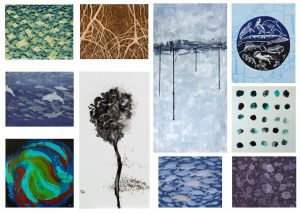Art and Oil Spill Science Merge at USF
– JUNE 6, 2019
Albert Einstein considered art and science to be entwined, stating that “Experiencing the mysterious is the fundamental emotion that stands at the cradle of true art and science.” Now, more people can connect emotionally to the mysterious deep ocean through artistic renditions of oil spill science being displayed at the Nelson Poynter Memorial Library, University of South Florida, St. Petersburg (USFSP).
The artwork and photography represent ongoing Deepwater Horizon research funded by the Gulf of Mexico Research Initiative. Entitled After the Oil Spill: Life Below the Surface and Visions of Local Artists, the display features Tampa Bay artists Tessa Wilson, Teresa Navajo, and Curtis Whitwam, and photographer Danté Fenolio (San Antonio Zoo).
The original artwork represents research topics that the C-IMAGE consortium is addressing such as sedimented oil, ecotoxicology, and oil plume dynamics. The exquisite photography represents a dedicated effort by the DEEPEND consortium to catalog mysterious marine life that they encountered during their deep-ocean (200-1,500 meters depth) excursions. The consortia are encouraging their science communities to consider various perspectives as they communicate research to audiences, especially through combined art and science which help us interpret our world.
“As scientists, we know our research has impacts and application for current scientific literature and future studies, but this importance doesn’t always translate to the public or non-expert audiences,” explained Ben Prueitt, C-IMAGE Marketing & Communications Specialist and co-Program Manager. “The idea was to give our three artists the subjects of our studies and have them express the importance through their eyes and art. The artists’ unique styles come through in each of the pieces and embodies others’ perspectives of what oil spill research means to the Gulf of Mexico’s future.”
The art and photography will also live within the pages of the C-IMAGE two-volume book series featuring synthesized oil spill studies. “As we began to envision the two books we developed with Springer, we wanted to add a distinguishable feature to each section,” explained Sherryl Gilbert, C-IMAGE Assistant Director. “The book chapters are full of color figures, schematics, and process diagrams, but it was important to us to tap into other visualizations to capture people’s attention, and for these pieces to serve as inspiration for each section.”
The USFP library’s gallery program that hosts the exhibit was started to share art and research from the university’s community with its students. “The exhibits perfectly encompass this goal as the students learn about and connect to what they might do either as future researchers, future artists, or to help protect our Gulf environment,” said Kaya van Beyen, Interim Associate Dean of the Nelson Poynter Memorial Library at USFSP. “Viewing the paintings is a more introspective experience, one that connects the oil spill to what the Gulf environment means to us.”
The exhibit opened on April 18, 2019 in conjunction with the Deepwater Horizon 9th anniversary event Remember the Horizon: How USF research set a standard after the 2010 Gulf oil spill. The library, which is temporarily housing the exhibit through summer 2019, also hosted a reception followed by presentations from USF scientists Steven Murawski, Rebekka Larson (also affiliated with Eckerd College), Heather Judkins, and Isabel Romero who shared their research discoveries. Afterwards, the artists shared their perspectives on the environment and the public’s connection to the Gulf of Mexico.
The paintings and five deep-sea photographs will be on permanent display in the halls of the USF College of Marine Science. The remaining deep-sea photographs will be on permanent display in the halls of the USFSP Science & Technology building.
By Nilde Maggie Dannreuther. Contact maggied@ngi.msstate.edu with questions or comments.
************
This research was made possible in part by a grant from the Gulf of Mexico Research Initiative (GoMRI) to the Center for the Integrated Modeling and Analysis of Gulf Ecosystems III (C-IMAGE III) and to the Deep-Pelagic Nekton Dynamics of the Gulf of Mexico (DEEPEND) consortium.
The Gulf of Mexico Research Initiative (GoMRI) is a 10-year independent research program established to study the effect, and the potential associated impact, of hydrocarbon releases on the environment and public health, as well as to develop improved spill mitigation, oil detection, characterization and remediation technologies. An independent and academic 20-member Research Board makes the funding and research direction decisions to ensure the intellectual quality, effectiveness and academic independence of the GoMRI research. All research data, findings and publications will be made publicly available. The program was established through a $500 million financial commitment from BP. For more information, visit https://gulfresearchinitiative.org/.
© Copyright 2010-2019 Gulf of Mexico Research Initiative (GoMRI) – All Rights Reserved. Redistribution is encouraged with acknowledgement to the Gulf of Mexico Research Initiative (GoMRI). Please credit images and/or videos as done in each article. Questions? Contact web-content editor Nilde “Maggie” Dannreuther, Northern Gulf Institute, Mississippi State University (maggied@ngi.msstate.edu).










